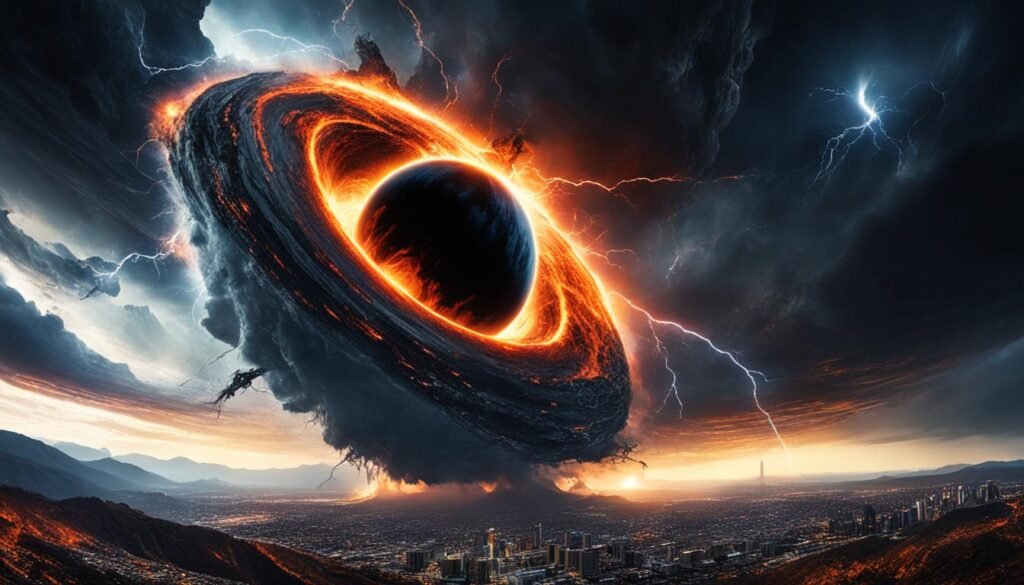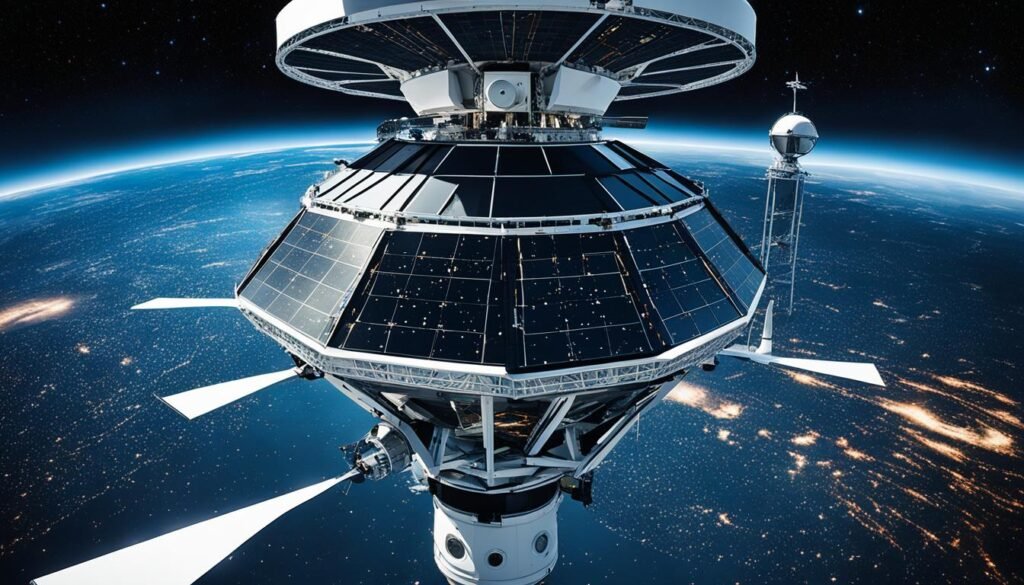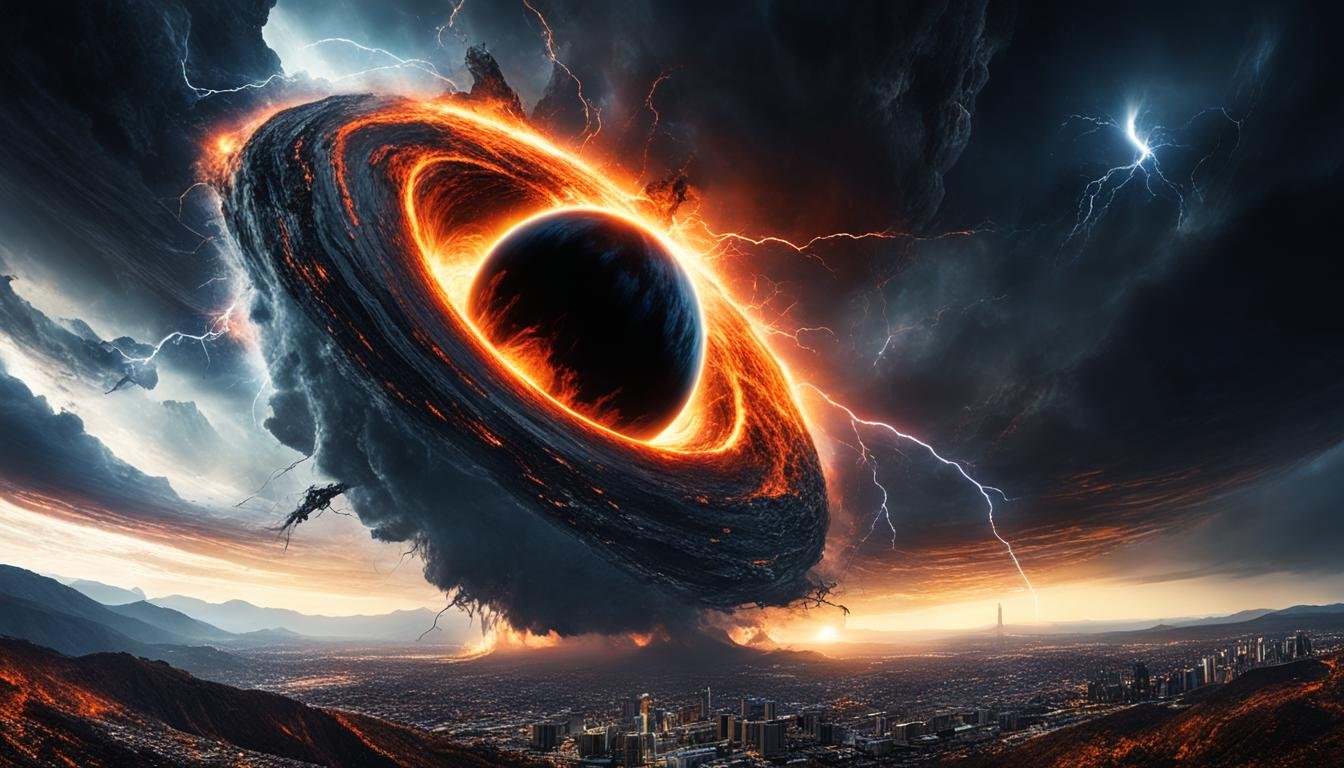Will a Black Hole Hit Earth? No. 1 explanation on internet.
Many wonder, when will a black hole hit Earth? The chance of a black hole colliding with Earth is extremely low. Scientists have studied the timeline of such a collision closely. They find comfort in the fact that the closest black hole is over 13.1 billion light-years away1. This black hole is in a younger universe, far from us. Hence, a disaster from a black hole seems centuries away, thanks to the vast cosmic distances.

Our tech lets us explore space and understand black holes better. We learn from the patterns and probabilities in the cosmos. Stellar-mass black holes, which form quickly and are massive, differ from supermassive quasars. These quasars appeared soon after the Big Bang and are incredibly powerful1. Yet, we still can’t predict when a black hole might hit Earth.
We keep a watchful eye on the skies, ready for any cosmic threats. Our aim is not fear, but curiosity about the universe. We’re driven by the desire to explore and understand. The vast universe is full of mysteries, yet the likelihood of a black hole disaster is very small right now.
The Astronomical Odds: Understanding Black Hole Proximity to Earth
We often wonder how close a black hole could get to Earth without causing disaster. The vast universe and the distances within it give us peace of mind. Really, black holes are so far away, they pose no danger to our planet.https://www.youtube.com/embed/AK44wAvv2E4
Looking into our galaxy, we find Earth’s risk of hitting a black hole is very low. Space is arranged to keep black holes far from us. This keeps Earth safe.
Probability and Distance: Cosmic Scales at Play
The Milky Way is huge, with stars and black holes moving around. The chance of a black hole hitting us is incredibly small. We just watch, safe from afar, thanks to the vast distances between us.
Historical Close Encounters: Learning from Scholz’s Star
History shows us some close approaches. Like Scholz’s star, which came near us long ago. It didn’t cause any trouble, but it reminds us we’re just a small part of the big universe.
Astrodynamic Movements: The Ever-Changing Universe
The universe is always moving. Stars and black holes dance, guided by gravity. This movement tells us that a black hole coming close to Earth is very unlikely in our lifetime.
Gravitational Billiards: The Theoretical Impact of Nearby Stars and Black Holes
The universe is like a huge pool table, where stars and planets constantly move. When two black holes collide, they release a massive amount of energy. This event occurred over a billion light-years away from Earth2. Such collisions show us the power of black holes, but our planet is safe. The discovery of gravitational waves lets us study these events up close2.
Thanks to new tech, we can now detect gravitational waves, once a mystery. The universe hides much from us, revealing secrets through gravity’s pull. Though we’ve made big leaps in understanding, the impact of black holes on Earth is still a guess2. Even with cosmic rays hitting us, more powerful than any human-made machine, Earth remains untouched3.
The idea of Earth getting too close to a black hole seems less scary now. Stephen Hawking suggested black holes shrink over time, not get bigger. Cosmic rays bombard our planet without causing damage. This proves nature has been conducting high-energy experiments long before us3.
| Cosmic Phenomenon | Energy Comparison | Potential Impact on Earth |
|---|---|---|
| Black Hole Merger2 | Three solar masses converted to energy | Negligible at over a billion light-years |
| Gravitational Waves Detected2 | First direct detection, revealing dark Universe | Scientific advancement, no physical impact |
| Cosmic Rays vs. LHC3 | Higher energy in cosmic rays | No harm to Earth, proving LHC’s safety |
We, as Earth’s caretakers, can relax knowing a black hole collision is not imminent. Our watchfulness is backed by advanced research and tools like the GEO600 interferometer. This instrument helps with LIGO Collaboration research2. So while the universe’s dance of stars and black holes is fascinating, our planet stands strong against these mighty giants.
Potential Impact of a Black Hole on Earth: Analyzing the Chances
Exploring the cosmos fills us with wonder and sharpens our analysis. The vast universe hints at a small chance of a black hole affecting Earth. Amidst vast space and celestial movements, we ponder if a black hole coming towards Earth is a real worry.
Geometric Considerations and Stellar Movements
Stars and planets move in precise patterns, set by the laws of physics. Our planet, far from the galaxy’s busy heart, stays safe from cosmic high-speed particles4. This places Earth well away from the harmful effects of black hole winds or radiation4.
Space Objects: From Rogue Planets to Black Holes
Black holes are not rare in space, as studies show5. The possibility of one heading our way makes us watch closely. Projects like the Event Horizon Telescope give us clearer pictures of these cosmic mysteries5.
Modelling Potential Disruptions in Our Solar System
Black holes move and affect their surroundings, catching scientists’ interest. They might change atmospheres or even deplete ozone layers around planets4. So, do they threaten Earth? Based on current research, we lean towards feeling safe rather than scared.

Create an image showing a scientist analyzing the potential impact of a black hole on Earth. The scientist is surrounded by charts and data, and is using advanced technology to measure the black hole’s distance and trajectory. The background should show images of Earth, space, and the black hole itself. The overall tone should be serious and scientific, conveying the high stakes involved in this analysis.
Scientists worldwide keep an eye on the skies, armed with the latest data. Theories like Hawking’s suggest black holes are not static but evolving. They push our understanding of space and the universe’s mysteries further5.
When Will a Black Hole Hit Earth?
Thinking about a black hole hitting Earth stretches our imagination. Scientists use models and data to explore this tiny chance. They study the cosmos, eager to learn about black holes, not scared.
The Long-Term Predictions: A Billion-Year Perspective
Wondering about a black hole hitting Earth puts us on a long timeline. It turns the black hole collision with earth into a game of chance over billions of years6. Sagittarius A, a huge black hole, is far but keeps our galaxy together6.
Variables and Uncertainties in Cosmic Forecasting
Predicting black hole collisions with Earth is complex. Stellar black holes are massive but invisible, making such events rare6. Each big galaxy has a supermassive black hole, yet they’re not a direct threat to us6.https://www.youtube.com/embed/Ufns1caByY4
We use satellites and telescopes to study space. They show us how gravity works around black holes. This helps us see that a big mass doesn’t mean danger to Earth6.
Our sun won’t become a black hole; it’s not massive enough. This fact comforts us and highlights our solid understanding of the universe’s mysteries6.
Black Hole Trajectory Towards Earth: Calculating the Risks
We have the important job of tracking black holes that might hit earth. Thanks to science and technology, we keep an eye on black holes that might come close to Earth. We see these mysterious happenings in the vast universe and carefully track their paths for our safety.

Create an image of a high-tech monitoring station perched on a mountaintop, surrounded by telescopes and radar dishes. In the distance, a massive black hole looms ominously, its event horizon visible as a dark circle against the starry sky. The scientists in the station are hard at work, monitoring the black hole’s trajectory and calculating its potential impact on Earth. The mood is tense and urgent as they work to gather as much data as possible, hoping to prevent catastrophe before it’s too late.
To keep us safe, we use radar imaging for detailed space object insights like asteroid 99942 Apophis. Its details come down to 38.75 meters (127 feet) per pixel7. Observations show Apophis was about 10.6 million miles (17 million kilometers) from Earth, with a small uncertainty of 150 meters (490 feet)7. These numbers help us plan our defense.
So, could a black hole ever reach earth? This thought is about the movement of space objects. We use big tools like the Green Bank Telescope and the Goldstone Complex to follow their paths. Objects like Apophis get tracked over huge distances, when it will pass by Earth closely on April 13, 20297.
Did you know one in six big near-Earth asteroids has a two-lobed shape7? We use patterns and algorithms to keep track of these space rocks. This helps us stay ready for any unlikely visitors from space.
To ease worries, top organizations like NASA analyze to confirm we are safe. It’s a mix of human smarts and computer power that keeps us looking out into space. We make sure to spot, measure, and lessen any tiny risks.
Monitoring Black Holes That Could Approach Earth: The Role of Technology
We are the guardians of our planet’s safety. We use black hole collision threat assessment technology to keep Earth safe. The Gaia spacecraft helps us spot tiny changes in gravity. These changes hint at near-Earth black holes. Thanks to this technology, we can look beyond light to see dangers in space.
Cutting-Edge Detection: Gaia Spacecraft and Gravitational Lensing
The Gaia spacecraft has improved our chances of finding black holes. It uses gravitational lensing, where light bends around massive objects like black holes. These findings are crucial for understanding how black holes move toward us. Visit this link for more on black hole detection.
The Future of Space Surveillance: Upcoming Missions and Tools
Space surveillance is getting better with new missions on the way. These missions will make our detection methods better. We’ll understand the universe’s mysteries more clearly. This gives us a better chance to protect Earth from any danger.
Minimizing Risks: Earth’s Safety Measures Against Potential Cataclysm
We are working to reduce risks from space, like black hole collisions. Our safety plans come from teamwork and detailed analysis. Observatories have given us data for decades. This shows how hard we work to keep Earth safe8.

Create an image of a powerful space observatory scanning the skies, with a network of antennas and satellites surrounding it. Show the observatory using advanced technology to detect and track potential threats, such as black holes, that could pose a risk to Earth. Make the image futuristic and sleek, with bright lights and detailed textures that convey the precision and sophistication of the surveillance system. Use a color scheme that evokes a sense of danger and urgency, such as reds, oranges, and yellows combined with deep blues and purples. Avoid including any human figures or recognizable elements that would distract from the focus on the technology and its mission.
Binary supermassive black holes show the huge forces we face8. These black holes are getting ready to collide soon. It shows why we must keep observing space8. Our goal is to keep Earth safe from any possible space threat.
Conclusion
Thinking about our place in the huge cosmos, we may wonder if a black hole collision with Earth could happen. But, our knowledge of space tells us it’s very unlikely soon. The nearest black hole found is three times the sun’s mass and 1,500 light-years away.9 Even so, there’s no increased danger to our planet.
Finding small black holes is a tough job for astronomers. There’s a “mass gap” for black holes under five solar masses.9 This gap may be due to hard-to-find X-ray emissions.9 Yet, with tools like the Gaia spacecraft, Sloan Digital Sky Survey, and Vera C. Rubin Observatory, we hope to get better at spotting them.9
It’s up to us to explore and learn from the universe’s vast mysteries. Upcoming discoveries will deepen our knowledge, as shared in our summary on black hole impacts.9 For now, we can be thankful. Our spot in the universe seems safe from these mysterious space giants.9
FAQ
When will a black hole hit Earth?
A black hole hitting Earth is highly unlikely. Scientists say if it ever happens, it would be billions of years away.
How close is the nearest black hole to Earth?
The closest black hole, called ‘V616 Monocerotis’, is about 3,000 light-years from us. That’s a big distance, making a collision very unlikely.
Have we had any close encounters with other celestial bodies like we fear from a black hole?
Yes, Earth has seen close calls before. About 70,000 years ago, Scholz’s star came within 0.8 light-years. But, it didn’t harm Earth.
What are the potential consequences if a black hole were to impact Earth?
If a black hole hit Earth, it would be a disaster. Our planet would be sucked into the black hole. But astronomers aren’t worried because it’s so unlikely.
How do scientists calculate the chances of a black hole colliding with Earth?
Scientists use computers and models to predict black holes’ paths. They consider the huge distances and long times involved.
Are there any black holes on a collision course with Earth right now?
No black holes are known to be heading our way. Astronomers are always watching the skies, just in case.
What technology is used to monitor black holes and potential risks to Earth?
Devices like the Gaia spacecraft help us watch the stars. Soon, the Nancy Roman Telescope will also help spot black holes by their gravity effects.
What safety measures could Earth take against a potential black hole collision?
Though a black hole hit is unlikely, space research keeps us alert. Maybe one day, tech could even move Earth if we had to.

